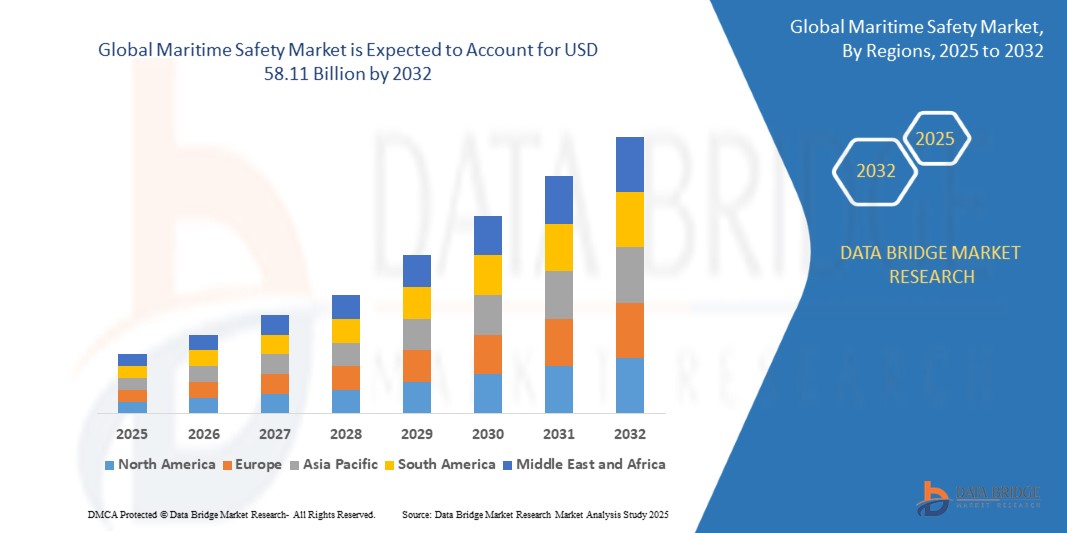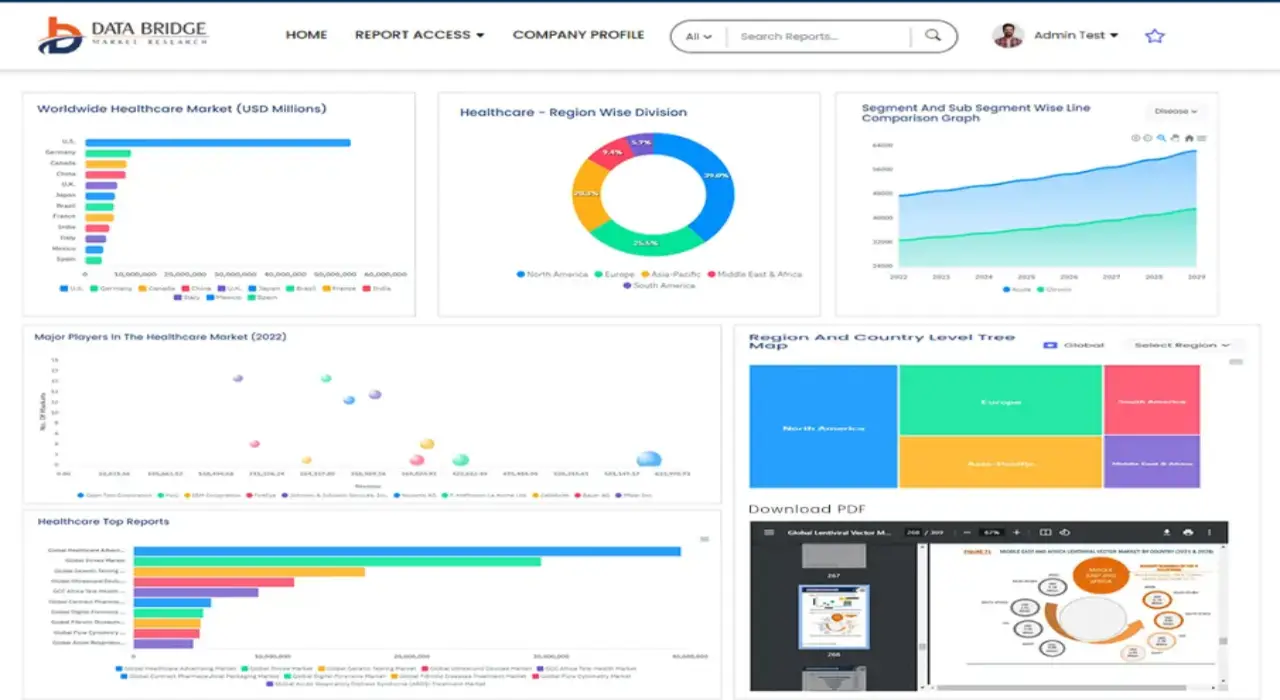Global Maritime Safety Market
Market Size in USD Billion
CAGR :
% 
 USD
29.77 Billion
USD
58.11 Billion
2024
2032
USD
29.77 Billion
USD
58.11 Billion
2024
2032
| 2025 –2032 | |
| USD 29.77 Billion | |
| USD 58.11 Billion | |
|
|
|
|
Global Maritime Safety Market Segmentation, By Range (Short Range, Medium Range and Long Range), Product (Tripod Mounted, Fixed CMM Based, Portable CMM Based and Desktop), Type (Optical Scanner, Laser Scanner and Structured Light Scanner), Offering (Hardware and Software and After- Sales Services), Application (Reverse Engineering, Quality Control and Inspection and Virtual Simulation), End Users (Automotive, Healthcare, Aerospace and Defence, Architecture and Construction, Energy and Power, Tunnel and Mining and Artefact and Heritage Preservation Department) - Industry Trends and Forecast to 2032
Maritime Safety Market Size
- The Global Maritime Safety Market size was valued at USD 29.77billion in 2024 and is expected to reach USD 58.11 billion by 2032, at a CAGR of 8.72% during the forecast period
- This market growth is driven by factors such as rising international trade and freight transport activities, increased demand for advanced maritime security systems, the integration of AI and robotics in maritime safety applications, and the growing focus on vessel and port security.
Maritime Safety Market Analysis
- Maritime safety solutions are indispensable across sectors such as shipping, offshore energy, port operations, and naval defense, offering critical systems for surveillance, vessel tracking, access control, and threat detection. These technologies play a vital role in ensuring the safety of maritime personnel, cargo, and infrastructure while meeting international compliance and regulatory standards.
- The market demand is significantly driven by the surge in international seaborne trade, rising threats of maritime piracy and terrorism, and the increasing implementation of AI-powered surveillance and tracking systems to bolster coastal and port security. Furthermore, supportive governmental regulations and growing investments in smart port infrastructure are enhancing the uptake of advanced maritime safety solutions.
- North America is expected to dominate the Global Maritime Safety Market throughout the forecast period, attributed to the presence of advanced defense systems, strong enforcement by coast guard agencies, and high adoption of integrated maritime safety platforms for both civilian and military applications.
- Asia-Pacific is projected to be the fastest-growing region in the market, driven by rapid growth in port infrastructure, increasing maritime trade, rising government expenditure on coastal security, and heightened awareness around maritime safety compliance in countries such as China, India, and South Korea.
- The port and critical infrastructure security segment is anticipated to lead the Global Maritime Safety Market with a substantial share of 43.61%, driven by the increasing demand for enhanced security measures in key maritime locations such as ports, docks, and shipping terminals. This segment is essential for safeguarding critical infrastructure against threats such as terrorism, unauthorized access, and environmental hazards.
Report Scope and Maritime Safety Market Segmentation
|
Attributes |
Maritime Safety Key Market Insights |
|
Segments Covered |
|
|
Countries Covered |
North America
Europe
Asia-Pacific
Middle East and Africa
South America
|
|
Key Market Players |
|
|
Market Opportunities |
|
|
Value Added Data Infosets |
In addition to the insights on market scenarios such as market value, growth rate, segmentation, geographical coverage, and major players, the market reports curated by the Data Bridge Market Research also include import export analysis, production capacity overview, production consumption analysis, price trend analysis, climate change scenario, supply chain analysis, value chain analysis, raw material/consumables overview, vendor selection criteria, PESTLE Analysis, Porter Analysis, and regulatory framework. |
Maritime Safety Market Trends
“Increasing Maritime Trade and Global Shipping Activities”
- One of the key drivers for the growth of the Maritime Safety Market is the continuous increase in global maritime trade and shipping activities. As more goods are transported by sea due to its cost-effectiveness, the demand for robust maritime safety measures also rises to ensure the security of ships, cargo, crew, and coastal areas.
- This rise in shipping activities is directly linked to increased risks associated with navigation, piracy, accidents, and environmental hazards, which necessitates the use of advanced maritime safety technologies like surveillance, tracking systems, and safety management tools.
- Increased maritime trade also drives the demand for more efficient port security solutions, surveillance equipment, and real-time monitoring systems to prevent and respond to security breaches and maritime disasters.
For instance:
- In Singapore, one of the busiest shipping hubs in the world, the implementation of advanced surveillance systems and automated access control technologies ensures the safety of cargo and personnel. As global trade continues to grow, ports like these invest heavily in such technologies to keep pace with the increasing traffic and threats.
Maritime Safety Market Dynamics
Driver
“Increasing Demand for Advanced Maritime Safety Solutions Due to Rising Security Threats”
- Another important driver of market growth is the increasing security threats to maritime vessels, such as piracy, terrorism, and illegal trafficking. These rising threats have highlighted the need for more sophisticated, integrated safety and security systems for both commercial and military vessels.
- As threats to maritime security evolve, so do the technologies required to counter them. This has spurred advancements in radar and optronics, thermal imaging, underwater surveillance, and communication systems, all of which are becoming increasingly important in ensuring the safety of vessels and ports.
- Governments, naval forces, and maritime companies are investing heavily in these technologies to safeguard not only their assets but also ensure the safety of international trade routes.
For instance:
- Companies like Northrop Grumman and Raytheon Anschütz are developing and deploying advanced radar systems and thermal imaging solutions to protect vessels from piracy, particularly in high-risk areas like the Horn of Africa. These technologies provide real-time monitoring of the surrounding waters, allowing early detection of potential threats.
Opportunity
“Integration of AI and Robotics in Maritime Safety Systems”
- One of the most promising opportunities in the Maritime Safety Market is the integration of Artificial Intelligence (AI) and robotics into safety systems. The convergence of these technologies can enhance real-time decision-making, improve predictive maintenance capabilities, and automate security protocols for vessels, ports, and coastal areas.
- AI-powered systems can analyze vast amounts of data from various sensors (such as radar, sonar, and thermal imaging) in real-time, providing actionable insights and early detection of potential security breaches or hazardous events. Robotics, on the other hand, can be used for underwater inspections, remote-controlled vessels, and autonomous security systems, reducing human intervention in dangerous environments.
- The growing focus on operational efficiency, reduced manpower costs, and the need for advanced safety measures are expected to drive this technological adoption.
For instance:
- Companies like Kongsberg have developed autonomous vessels that use AI to make navigation decisions, thereby improving maritime safety while reducing the risk of human error. These vessels are used for surveillance, transportation, and offshore operations, significantly enhancing the safety of personnel working in high-risk environments.
Restraint/Challenge
“Lack of Standardization Across Global Maritime Safety Systems”
- A major challenge limiting the growth of the Maritime Safety Market is the lack of standardization in safety protocols, technologies, and systems across different regions. While many countries have their own set of regulations and safety measures, the absence of globally accepted norms and frameworks makes it difficult for multinational companies and agencies to implement consistent safety solutions.
- This lack of standardization leads to inefficiencies, with organizations often needing to adapt their systems to comply with local regulations, which can increase operational costs and slow down implementation. Moreover, it can also hinder international cooperation, as various countries may use different maritime safety technologies or standards.
- Furthermore, differences in system interoperability can lead to delays in sharing critical information in case of maritime accidents or security threats, reducing the overall effectiveness of safety operations.
For instance:
- Maritime companies operating in both the EU and the US face the challenge of navigating two distinct regulatory environments. In the EU, the European Maritime Safety Agency (EMSA) has its own set of regulations, while the U.S. Coast Guard follows different standards. Companies like Lockheed Martin and Raytheon Anschütz, which offer maritime safety solutions, must ensure that their products comply with both regions' regulations, adding complexity to their operations.
Maritime Safety Market Scope
The maritime safety market is segmented on the basis of technologies and systems, services, categories and application.
|
Segmentation |
Sub-Segmentation |
|
By Technologies and Systems |
|
|
By Services |
|
|
By Categories |
|
|
By Applications
|
|
In 2025, the Surveillance and Tracking Segment is Projected to Dominate the Market in the Technologies and Systems Segment
The surveillance and tracking segment is expected to lead the Maritime Safety Market in 2025, driven by the increasing demand for real-time monitoring and security of maritime operations. Surveillance technologies such as radar, underwater surveillance, video surveillance, and thermal imaging are essential for monitoring maritime traffic, detecting threats like piracy, and ensuring the safety of vessels and coastal areas.
In 2025, the Vessel Security Segment is Expected to Lead the Market in the Categories Segment
The vessel security segment is projected to capture the largest share in 2025, driven by growing concerns over piracy and maritime terrorism. Advanced security systems that include radar, communication, and access control technologies are increasingly being integrated into vessels to safeguard crew, cargo, and the vessel itself.
Maritime Safety Market Regional Analysis
“North America Holds the Largest Share in the Maritime Safety Market”
- North America is the leading region in the Maritime Safety Market, driven by robust industrial infrastructure, advanced maritime technologies, and a focus on national security and safety regulations.
- The United States is particularly influential, with major players like Honeywell International and Northrop Grumman investing heavily in maritime safety solutions for both defense and commercial sectors.
- A significant factor contributing to the region’s dominance is the extensive use of advanced technologies such as radar systems, access control, and surveillance in maritime operations to enhance security against terrorism and piracy.
- Furthermore, the U.S. Coast Guard’s continuous focus on safeguarding critical infrastructure and maritime borders, combined with a well-developed regulatory environment, supports the growth of maritime safety technologies in North America.
“Asia-Pacific is Projected to Register the Highest CAGR in the Maritime Safety Market”
- The Asia-Pacific region is anticipated to experience the fastest growth in the Maritime Safety Market due to rapid industrialization, increasing trade, and heightened maritime security concerns.
- Countries like China, Japan, and South Korea are driving market expansion, with China’s growing shipping industry and Japan’s emphasis on maritime technology adoption, including surveillance, communication, and vessel safety systems.
- The surge in manufacturing and port activity in India, along with the country’s increasing focus on coastal surveillance and maritime security, further accelerates market growth.
- Additionally, regional threats such as piracy in Southeast Asia and the Indian Ocean, coupled with defense spending, are fostering demand for advanced maritime safety solutions across various sectors, including naval defense and port security.
Maritime Safety Market Share
The market competitive landscape provides details by competitor. Details included are company overview, company financials, revenue generated, market potential, investment in research and development, new market initiatives, global presence, production sites and facilities, production capacities, company strengths and weaknesses, product launch, product width and breadth, application dominance. The above data points provided are only related to the companies' focus related to market.
The Major Market Leaders Operating in the Market Are:
- BAE Systems(United Kingdom)
- Honeywell International Inc.(United States)
- Northrop Grumman(United States)
- Raytheon Anschütz(Germany)
- Saab(Sweden)
- Elbit Systems Ltd.(Israel)
- L3Harris Technologies, Inc.(United States)
- KONGSBERG (Norway)
- Leonardo S.p.A.(Italy)
- GRUPO EULEN (Spain)
- ABS Group of Companies, Inc. (United States)
- Consilium Marine & Safety AB (Sweden)
- Vane Brothers (United States)
- Solas Marine Services Group. (United Kingdom)
- Siam Global Marine Safety Co., Ltd.(Thailand)
- L3Harris Technologies, Inc. (listed again)(United States)
- Thales Group(France)
Latest Developments in Global Maritime Safety Market
- In March 2025, Saab AB announced the deployment of its new Sea Giraffe 1X radar system for coastal surveillance in Southeast Asia. This advanced surveillance radar provides enhanced situational awareness with real-time threat detection capabilities, enabling faster response to maritime security incidents such as piracy and unauthorized intrusions.
- In January 2025, Thales Group launched an upgraded version of its Maritime Safety Management Platform, integrating AI-driven analytics and satellite-based communications. This platform enhancement enables proactive threat assessment and seamless coordination between naval authorities, coast guards, and maritime operators, strengthening overall maritime domain awareness.
- In December 2024, Elbit Systems Ltd. secured a contract to supply its advanced coastal surveillance systems to a European naval agency. The system integrates thermal imaging, radar, and automatic identification system (AIS) capabilities, designed to enhance maritime border protection and detect illegal activities such as smuggling and unauthorized vessel entries.
- In October 2024, KONGSBERG expanded its maritime safety portfolio by unveiling a new autonomous surface vessel (ASV) monitoring solution. This solution offers real-time communication, collision avoidance, and remote diagnostics, targeting defense, environmental monitoring, and offshore energy sectors.
SKU-
Get online access to the report on the World's First Market Intelligence Cloud
- Interactive Data Analysis Dashboard
- Company Analysis Dashboard for high growth potential opportunities
- Research Analyst Access for customization & queries
- Competitor Analysis with Interactive dashboard
- Latest News, Updates & Trend analysis
- Harness the Power of Benchmark Analysis for Comprehensive Competitor Tracking
Research Methodology
Data collection and base year analysis are done using data collection modules with large sample sizes. The stage includes obtaining market information or related data through various sources and strategies. It includes examining and planning all the data acquired from the past in advance. It likewise envelops the examination of information inconsistencies seen across different information sources. The market data is analysed and estimated using market statistical and coherent models. Also, market share analysis and key trend analysis are the major success factors in the market report. To know more, please request an analyst call or drop down your inquiry.
The key research methodology used by DBMR research team is data triangulation which involves data mining, analysis of the impact of data variables on the market and primary (industry expert) validation. Data models include Vendor Positioning Grid, Market Time Line Analysis, Market Overview and Guide, Company Positioning Grid, Patent Analysis, Pricing Analysis, Company Market Share Analysis, Standards of Measurement, Global versus Regional and Vendor Share Analysis. To know more about the research methodology, drop in an inquiry to speak to our industry experts.
Customization Available
Data Bridge Market Research is a leader in advanced formative research. We take pride in servicing our existing and new customers with data and analysis that match and suits their goal. The report can be customized to include price trend analysis of target brands understanding the market for additional countries (ask for the list of countries), clinical trial results data, literature review, refurbished market and product base analysis. Market analysis of target competitors can be analyzed from technology-based analysis to market portfolio strategies. We can add as many competitors that you require data about in the format and data style you are looking for. Our team of analysts can also provide you data in crude raw excel files pivot tables (Fact book) or can assist you in creating presentations from the data sets available in the report.














